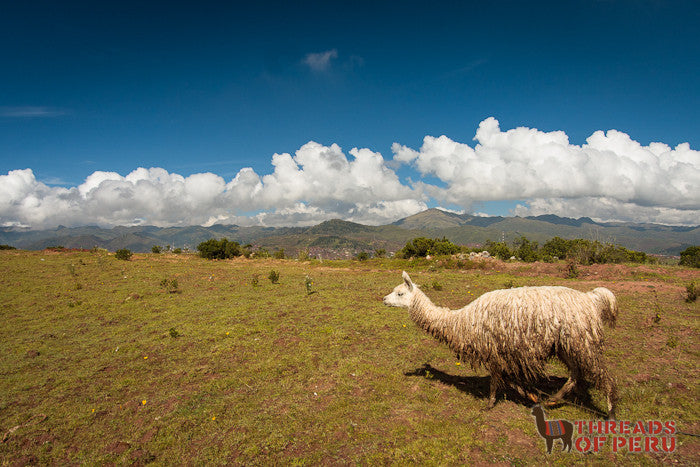From the time I arrived in Cusco, I’ve been eager to get out. Not because the city isn’t wonderful but because I know that the land and natural beauty surrounding the city is where our weavers draw inspiration from. Like wine and chocolate, their cloth carries a flavor of these mountains and majesty with it. I wanted to experience that flavor for myself, and set out early one Sunday morning for a place called Chacán Cave.

The morning was foggy and tamale vendors crouched close to their warm metal pots, waiting for the hungry crowds on their way to Mass. We climbed from Cusco’s main plaza, the Plaza de Armas, up 600 steps through the San Blas neighborhood. This put us high on a hill overlooking the city and the ruins of Sacsayhuamán. These ruins are the site of a battle fought between Incan warriors and conquistadors. In this altitude, walking is hard enough; fighting, I can’t imagine.
Behind Sacsayhuamán, the wildness of the mountains began to creep in. The roads are paved and tour buses lumbered along them but behind the buses alos= ran shaggy ponies. I watched as their hooves clicked sharply on the pavement, fleeing from a horseman and the twirling rag in his hand.
After leaving the asphalt, we hiked a dirt path that rose sharply from the road. As we climbed, I thought about this place, its people, its animals, its vegetation and how they are almost defined by the verticality of life here.
We crested the hill near a crumbling cairn. Rainy season was nearing its end and the path was covered in a heavy blanket of grass. At places the way forward was marked only by a shallow depression in the earth, worn by years of sandaled feet. I took in the colors, vibrant from recent rains. Green and yellow and blue and purple and red, deep earthen red; the colors of grass, flowers, and mud.

At a place where our path joined a larger track, we met a pair of young boys. They pointed us in the right direction, past a large boulder and up a grassy hill. Soon the trail disappeared, swallowed again by the blanket of grass. I followed a set of horse’s hoof prints until I reached the top of the hill.
At the top, most of the vegetation had turned to tufts of straw. Below I could see a reservoir with an earthen dyke and shepherd boys tending animals at its shore. Beyond the boys a small village lay on the side of a hill, with a few red adobe houses, shelters the color of the earth they were pulled from.

From my vantage point, it was easy to see that this was a hard land. The thin air, scorching sun, and rough earth make survival in the mountains above Cusco a challenge. But in the rugged ground and in the stubbled grasses I could also see a profound beauty.
On top of that hill, I felt like I could almost touch the clouds, and walking through those mountains had shown me a glimpse of the almost endless trails pushing their way back to staggering peaks. The grazing livestock I had seen, with matted coats on their backs and bunches of grass in their mouths, seemed lost in the impressive scale of this alpine landscape.

After descending the hill it didn’t take long to reach the natural bridge which forms Chacán Cave. A short but steep trail lead us to the cave’s mouth and to the bank of the rain-swollen river that flows through the Tica Tica valley. As we rested by the river’s edge, details of our surroundings emerged.
On a nearby hillside a boy cut grain, above us a pair of tethered donkeys grazed, and nearby wildflowers shivered in the breeze. The longer I looked, the more I realized how far back the traces of humanity stretched in this valley. It was almost impossible to look in any direction without seeing old brickwork clinging to the valley’s walls.

We walked home on a different road but the abundant beauty of our surroundings was not lessened. We watched llamas graze and looked at red houses set against the blue-green panorama of earth and sky.
I think it would take a lifetime in the Andes to grasp everything that inspires our weavers; but I feel, if only slightly, that I’m beginning to understand. This place is wild. It is an awesome show of nature’s force; rock carved by ice and water, plants and animals adapted to life in the extreme. But this place is also home to a wealth of human history and tradition, set for ages in brick and stone. Inspiration comes equally from the land and the past. A meeting of forces so great that the existence of a moving artistic tradition was almost inevitable.

